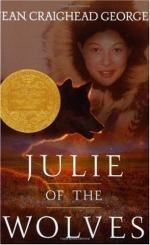|
This section contains 387 words (approx. 1 page at 400 words per page) |

|
Julie of the Wolves Summary & Study Guide Description
Julie of the Wolves Summary & Study Guide includes comprehensive information and analysis to help you understand the book. This study guide contains the following sections:
This detailed literature summary also contains Further Study and a Free Quiz on Julie of the Wolves by Jean Craighead George.
On one level, Julie of the Wolves is a book about survival in the wilderness. A young Eskimo girl, named both Julie Edward (her American name) and Miyax Kapugen (her Eskimo name), runs away from a traditional planned marriage that she finds intolerable. She becomes lost on the vast North Slope of the Alaskan Brooks Range, far away from even the most remote settlement. The long arctic winter is coming on and Julie must call on all her wits, her Eskimo skills, and her sensitivity to nature to find the food and shelter she needs to survive. Near her camp, she discovers a wolf den and determines that somehow she must find a way to make the wolves share their resources with her if she is to live.
On another, more metaphysical level, Julie of the Wolves is about being lost in a culture. Julie runs away from the Eskimo village thinking that she will go to live with her pen pal in San Francisco.
Her experience alone on the tundra with the wolves, however, teaches her the value and beauty of the Eskimo ways.
She learns to hate modern civilization, which she views as being out of touch with the natural world. She gives up the idea of San Francisco and almost decides to live her life alone on the tundra.
A certain ambivalence, however, takes hold of her, and she journeys towards human settlement. At last she meets another Eskimo couple and learns from them that her father, Kapugen, whom she had thought dead, is not only alive but a leader in the nearby town of Kangik. Her goal changes: she will go to live with her Eskimo father and practice the old ways that he taught her as a child.
But when she gets there she finds that he has made compromises and adopted some of the modern ways.
Narrative tension arises from two major sources—the practical matter of how Julie will survive on the tundra, and the philosophical matter of how she will resolve the problem of her cultural identity. Julie struggles, like many young members of other ethnic groups, to work out on a very personal level some kind of compromise between the old culture that defines her people and the disparate values and methods of modern society.
Read more from the Study Guide
|
This section contains 387 words (approx. 1 page at 400 words per page) |

|



